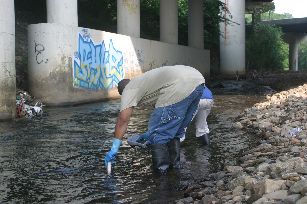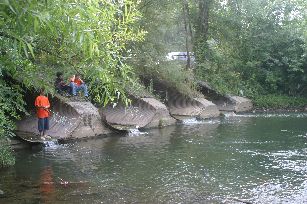 Water sampling at an urban stream in Baltimore City. Water sampling at an urban stream in Baltimore City.
 Kids fishing at a sewage-contaminated storm-water outfall in Gwynns Falls.
Kids fishing at a sewage-contaminated storm-water outfall in Gwynns Falls.
|
URBAN WATERSHED FORESTRY RESTORATION OF STORM WATER WATERSHED 263
Investigator: Rich Pouyat, Ken Belt, Claire Welty, Upal Ghosh. Brian Reed
Funding agency: US Forest Service
Background. Existing watershed management models do not work
well in blighted, inner-city areas such as Watershed #263. This is
because urban, inner city neighborhoods are typically isolated from
environmental
resources that would benefit from their action and the use of conventional
urban restoration practices (e.g., wetland creation) is prohibitively
expensive.
Research Objectives. The purpose of this project is to prepare a model urban watershed management plan prepared in partnership with Baltimore City Department of Public Works with active community participation. The project watershed is called “Number 263” and
is based on the drainage characteristics of the storm drain system in
six urban neighborhoods (and part of four others) with a high percentage
of impervious surfaces (more than 40 percent) and significant urban forest
deficit (existing tree canopy of less than 6 percent, far below the city
average of 30 percent). The project is envisioned to be a model that can be transferred
to other urban storm sewer watersheds by replicating many of the restoration
treatment techniques and community stewardship models.
The primary goal of this research is to measurably improve water quality, Chesapeake Bay living resources, and social and environmental conditions in a small urban storm sewer watershed area through the implementation of community-based restoration projects. This project is being carried out through a multi-organization collaboration among the City of Baltimore, Parks and People Foundation, The US Forest Service, KCI Technologies, and the University of Maryland Baltimore County.
Key questions to be addressed in this research at UMBC are:
1. What are the levels of key priority pollutants in the watershed effluent?
2. What are the sources of the prominent priority and emerging pollutants in the watershed?
3. How does the water quality change after the implementation of the restoration projects?
|